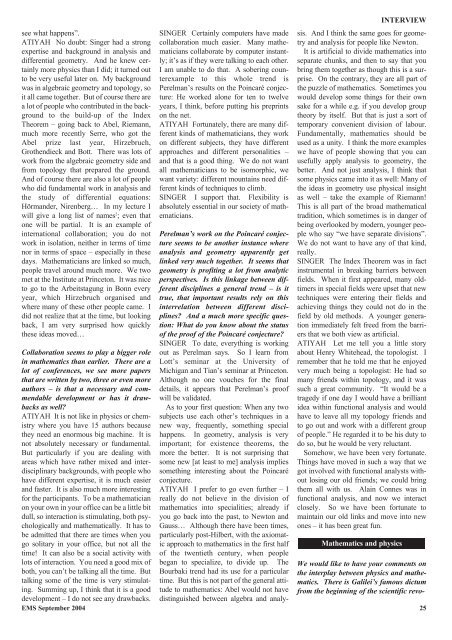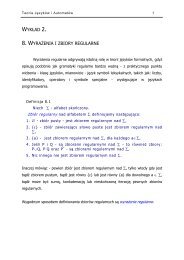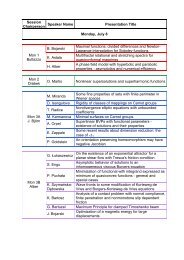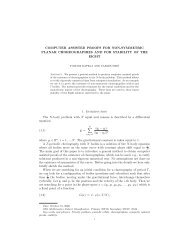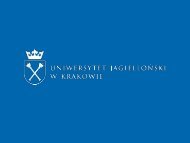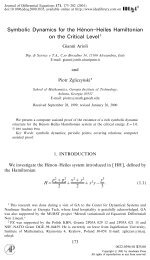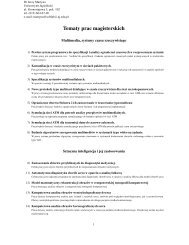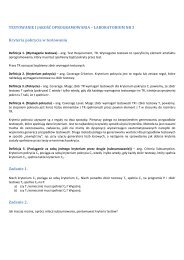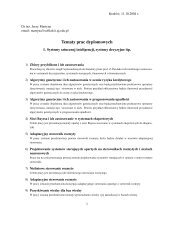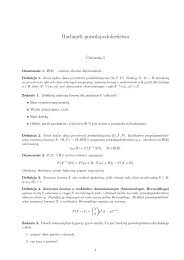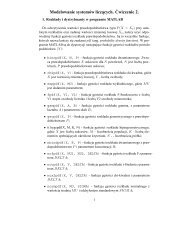Interview with Michael Atiyah and Isadore Singer
Interview with Michael Atiyah and Isadore Singer
Interview with Michael Atiyah and Isadore Singer
You also want an ePaper? Increase the reach of your titles
YUMPU automatically turns print PDFs into web optimized ePapers that Google loves.
see what happens”.<br />
ATIYAH No doubt: <strong>Singer</strong> had a strong<br />
expertise <strong>and</strong> background in analysis <strong>and</strong><br />
differential geometry. And he knew certainly<br />
more physics than I did; it turned out<br />
to be very useful later on. My background<br />
was in algebraic geometry <strong>and</strong> topology, so<br />
it all came together. But of course there are<br />
a lot of people who contributed in the background<br />
to the build-up of the Index<br />
Theorem – going back to Abel, Riemann,<br />
much more recently Serre, who got the<br />
Abel prize last year, Hirzebruch,<br />
Grothendieck <strong>and</strong> Bott. There was lots of<br />
work from the algebraic geometry side <strong>and</strong><br />
from topology that prepared the ground.<br />
And of course there are also a lot of people<br />
who did fundamental work in analysis <strong>and</strong><br />
the study of differential equations:<br />
Hörm<strong>and</strong>er, Nirenberg… In my lecture I<br />
will give a long list of names 2 ; even that<br />
one will be partial. It is an example of<br />
international collaboration; you do not<br />
work in isolation, neither in terms of time<br />
nor in terms of space – especially in these<br />
days. Mathematicians are linked so much,<br />
people travel around much more. We two<br />
met at the Institute at Princeton. It was nice<br />
to go to the Arbeitstagung in Bonn every<br />
year, which Hirzebruch organised <strong>and</strong><br />
where many of these other people came. I<br />
did not realize that at the time, but looking<br />
back, I am very surprised how quickly<br />
these ideas moved…<br />
Collaboration seems to play a bigger role<br />
in mathematics than earlier. There are a<br />
lot of conferences, we see more papers<br />
that are written by two, three or even more<br />
authors – is that a necessary <strong>and</strong> commendable<br />
development or has it drawbacks<br />
as well?<br />
ATIYAH It is not like in physics or chemistry<br />
where you have 15 authors because<br />
they need an enormous big machine. It is<br />
not absolutely necessary or fundamental.<br />
But particularly if you are dealing <strong>with</strong><br />
areas which have rather mixed <strong>and</strong> interdisciplinary<br />
backgrounds, <strong>with</strong> people who<br />
have different expertise, it is much easier<br />
<strong>and</strong> faster. It is also much more interesting<br />
for the participants. To be a mathematician<br />
on your own in your office can be a little bit<br />
dull, so interaction is stimulating, both psychologically<br />
<strong>and</strong> mathematically. It has to<br />
be admitted that there are times when you<br />
go solitary in your office, but not all the<br />
time! It can also be a social activity <strong>with</strong><br />
lots of interaction. You need a good mix of<br />
both, you can’t be talking all the time. But<br />
talking some of the time is very stimulating.<br />
Summing up, I think that it is a good<br />
development – I do not see any drawbacks.<br />
SINGER Certainly computers have made<br />
collaboration much easier. Many mathematicians<br />
collaborate by computer instantly;<br />
it’s as if they were talking to each other.<br />
I am unable to do that. A sobering counterexample<br />
to this whole trend is<br />
Perelman’s results on the Poincaré conjecture:<br />
He worked alone for ten to twelve<br />
years, I think, before putting his preprints<br />
on the net.<br />
ATIYAH Fortunately, there are many different<br />
kinds of mathematicians, they work<br />
on different subjects, they have different<br />
approaches <strong>and</strong> different personalities –<br />
<strong>and</strong> that is a good thing. We do not want<br />
all mathematicians to be isomorphic, we<br />
want variety: different mountains need different<br />
kinds of techniques to climb.<br />
SINGER I support that. Flexibility is<br />
absolutely essential in our society of mathematicians.<br />
Perelman’s work on the Poincaré conjecture<br />
seems to be another instance where<br />
analysis <strong>and</strong> geometry apparently get<br />
linked very much together. It seems that<br />
geometry is profiting a lot from analytic<br />
perspectives. Is this linkage between different<br />
disciplines a general trend – is it<br />
true, that important results rely on this<br />
interrelation between different disciplines?<br />
And a much more specific question:<br />
What do you know about the status<br />
of the proof of the Poincaré conjecture?<br />
SINGER To date, everything is working<br />
out as Perelman says. So I learn from<br />
Lott’s seminar at the University of<br />
Michigan <strong>and</strong> Tian’s seminar at Princeton.<br />
Although no one vouches for the final<br />
details, it appears that Perelman’s proof<br />
will be validated.<br />
As to your first question: When any two<br />
subjects use each other’s techniques in a<br />
new way, frequently, something special<br />
happens. In geometry, analysis is very<br />
important; for existence theorems, the<br />
more the better. It is not surprising that<br />
some new [at least to me] analysis implies<br />
something interesting about the Poincaré<br />
conjecture.<br />
ATIYAH I prefer to go even further – I<br />
really do not believe in the division of<br />
mathematics into specialities; already if<br />
you go back into the past, to Newton <strong>and</strong><br />
Gauss… Although there have been times,<br />
particularly post-Hilbert, <strong>with</strong> the axiomatic<br />
approach to mathematics in the first half<br />
of the twentieth century, when people<br />
began to specialize, to divide up. The<br />
Bourbaki trend had its use for a particular<br />
time. But this is not part of the general attitude<br />
to mathematics: Abel would not have<br />
distinguished between algebra <strong>and</strong> analy-<br />
sis. And I think the same goes for geometry<br />
<strong>and</strong> analysis for people like Newton.<br />
It is artificial to divide mathematics into<br />
separate chunks, <strong>and</strong> then to say that you<br />
bring them together as though this is a surprise.<br />
On the contrary, they are all part of<br />
the puzzle of mathematics. Sometimes you<br />
would develop some things for their own<br />
sake for a while e.g. if you develop group<br />
theory by itself. But that is just a sort of<br />
temporary convenient division of labour.<br />
Fundamentally, mathematics should be<br />
used as a unity. I think the more examples<br />
we have of people showing that you can<br />
usefully apply analysis to geometry, the<br />
better. And not just analysis, I think that<br />
some physics came into it as well: Many of<br />
the ideas in geometry use physical insight<br />
as well – take the example of Riemann!<br />
This is all part of the broad mathematical<br />
tradition, which sometimes is in danger of<br />
being overlooked by modern, younger people<br />
who say “we have separate divisions”.<br />
We do not want to have any of that kind,<br />
really.<br />
SINGER The Index Theorem was in fact<br />
instrumental in breaking barriers between<br />
fields. When it first appeared, many oldtimers<br />
in special fields were upset that new<br />
techniques were entering their fields <strong>and</strong><br />
achieving things they could not do in the<br />
field by old methods. A younger generation<br />
immediately felt freed from the barriers<br />
that we both view as artificial.<br />
ATIYAH Let me tell you a little story<br />
about Henry Whitehead, the topologist. I<br />
remember that he told me that he enjoyed<br />
very much being a topologist: He had so<br />
many friends <strong>with</strong>in topology, <strong>and</strong> it was<br />
such a great community. “It would be a<br />
tragedy if one day I would have a brilliant<br />
idea <strong>with</strong>in functional analysis <strong>and</strong> would<br />
have to leave all my topology friends <strong>and</strong><br />
to go out <strong>and</strong> work <strong>with</strong> a different group<br />
of people.” He regarded it to be his duty to<br />
do so, but he would be very reluctant.<br />
Somehow, we have been very fortunate.<br />
Things have moved in such a way that we<br />
got involved <strong>with</strong> functional analysts <strong>with</strong>out<br />
losing our old friends; we could bring<br />
them all <strong>with</strong> us. Alain Connes was in<br />
functional analysis, <strong>and</strong> now we interact<br />
closely. So we have been fortunate to<br />
maintain our old links <strong>and</strong> move into new<br />
ones – it has been great fun.<br />
Mathematics <strong>and</strong> physics<br />
INTERVIEW<br />
We would like to have your comments on<br />
the interplay between physics <strong>and</strong> mathematics.<br />
There is Galilei’s famous dictum<br />
from the beginning of the scientific revo-<br />
EMS September 2004 25


